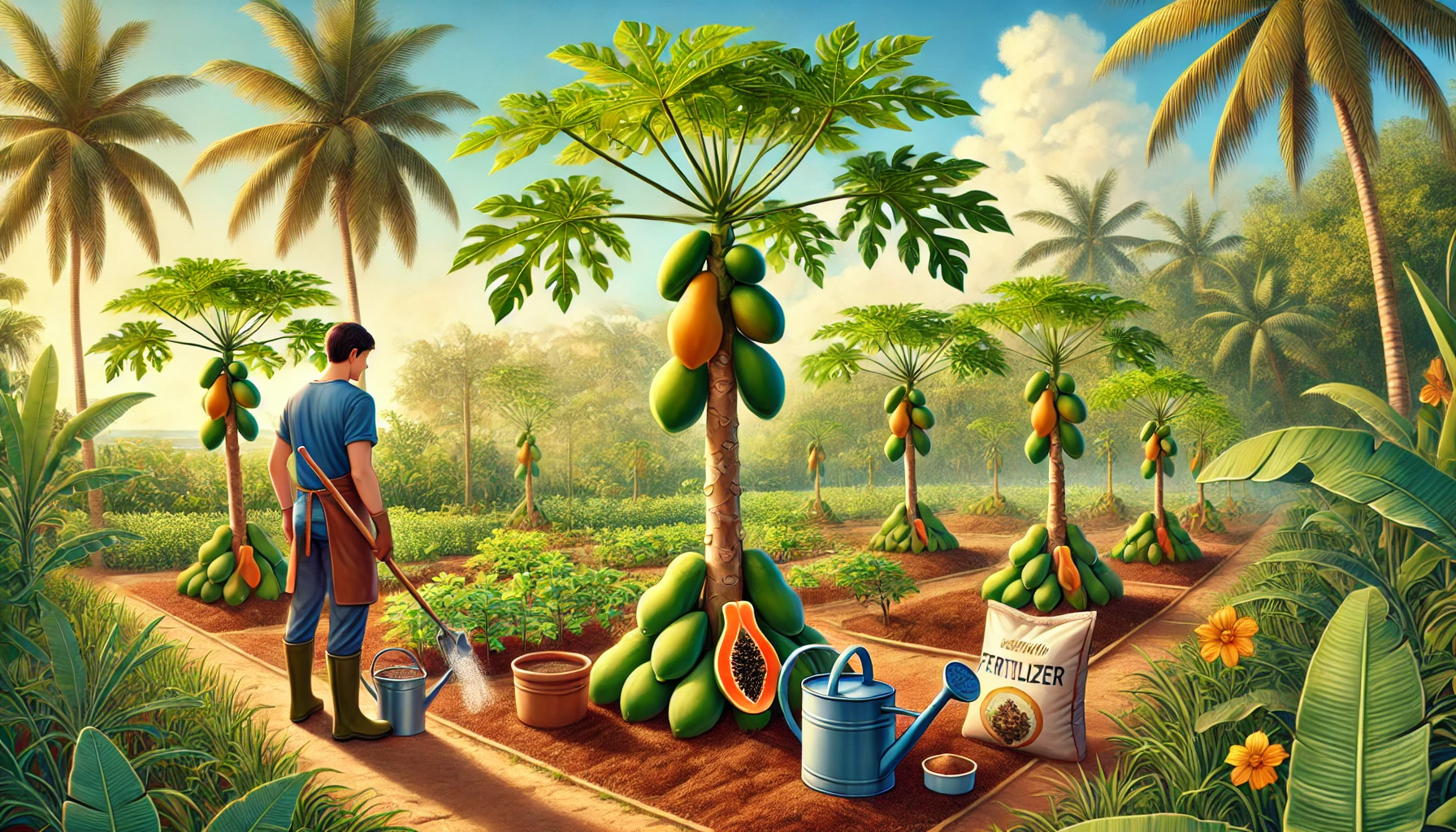Papayas are tropical fruits known for their sweet flavor and nutritional benefits. To grow healthy papaya plants and achieve a bountiful harvest, it’s essential to provide the right nutrients at each stage of their growth.
Here is a table that shows the approximate duration of each growth stage for papaya plants:
| Stage | Duration | Key Signs |
|---|---|---|
| Germination | 1-3 weeks | Seeds swell, split, and seedlings emerge |
| Seedling Stage | 4-8 weeks | First true leaves appear, stems thicken |
| Vegetative Growth | 2-4 months | Rapid leaf and stem growth, development of branches |
| Flowering | 1-2 months | Flower buds form, first flowers open |
| Fruit Development | 5-7 months | Fruits start forming and growing |
| Ripening | 1-3 months | Fruits mature, change color, ready for harvest |
This table provides a clear overview of the different stages of papaya plant growth, their typical durations, and key visual indicators for each stage.
Here’s the table with the “NPK Ratio” and “Nutrients” :
| Fertilizer | Nutrients | Benefits |
|---|---|---|
| Compost | NPK: 1-1-1, Balanced nutrients | Improves soil structure, increases microbial activity, enhances water retention |
| Manure | NPK: Varies (e.g., 0.5-0.2-0.4), Balanced nutrients | Adds organic matter, provides slow-release nutrients, improves soil aeration |
| Bone Meal | NPK: 4-12-0, High in phosphorus | Promotes root development, enhances flowering |
| Blood Meal | NPK: 12-0-0, High in nitrogen | Promotes lush growth, helps compost decomposition |
| Fish Emulsion | NPK: 5-2-2, Rich in micronutrients | Fast-acting, boosts plant growth |
| Seaweed Extract | NPK: 1-0-4, Trace minerals, growth hormones | Improves stress tolerance, enhances root development |
| Green Manure | NPK: Varies (e.g., 2-1-2), Nitrogen (legumes), organic matter | Adds organic matter, suppresses weeds, fixes nitrogen |
| Worm Castings | NPK: 1-0-0, Beneficial microbes | Enhances soil structure, provides slow-release nutrients |
| Alfalfa Meal | NPK: 3-1-2, Growth hormones | Promotes soil microbial activity, improves plant vigor |
| Cottonseed Meal | NPK: 6-2-1, Balanced nutrients | Acidifies soil, provides slow-release nutrients, improves soil texture |
| Bat Guano | NPK: 10-3-1, High in nitrogen | Promotes vigorous growth, rich in beneficial microbes |
| Feather Meal | NPK: 12-0-0, High in nitrogen | Slow-release fertilizer, promotes lush foliage |
| Neem Cake | NPK: 5-1-2, Balanced nutrients | Acts as a pesticide, enhances soil fertility, improves plant health |
| Kelp Meal | NPK: 1-0-2, Trace minerals | Promotes strong root development, enhances stress resistance |
| Coffee Grounds | NPK: 2-0.3-0.2, Nitrogen | Improves soil structure, attracts beneficial microorganisms |
| Molasses | NPK: 1-0-5, Energy source for microbes | Improves soil structure, enhances nutrient uptake |
| Rock Phosphate | NPK: 0-3-0, High in phosphorus | Promotes root growth, enhances flowering and fruiting |
| Wood Ash | NPK: 0-1-3, Potassium, calcium | Raises soil pH, provides potassium, contains trace elements |
| Epsom Salt | NPK: 0-0-0, Magnesium sulfate | Improves chlorophyll production, enhances nutrient uptake |
| Banana Peel Fertilizer | NPK: 0-3-42 (approximate), Potassium | Promotes strong root growth, enhances flowering and fruiting |
| Mustard Cake | NPK: 4-1-1, Balanced nutrients | Enhances soil fertility, promotes healthy plant growth |
| Eggshell Fertilizer | NPK: 1.2-0.4-0.1 (approximate), Calcium | Improves soil structure, reduces soil acidity, strengthens plant cell walls |
This table combines the NPK ratios with other nutrient information for a more streamlined presentation of each fertilizer’s key properties.
This guide outlines the key nutrients needed during different growth stages and their benefits to the plant.
Germination
Nutrients Needed:
- Phosphorus: Mix 1-2 tablespoons of Rock Phosphate into soil before planting to promote root development or Incorporate 1-2 tablespoons of Bone Meal into soil to provide phosphorus and other nutrients.
- Potassium: First dry and crush banana peel then mix 1-2 tablespoons with soil when planting each papaya seed. it Strengthens seedlings against disease.
Benefits:
- Phosphorus helps in establishing a strong root system, crucial for the uptake of water and nutrients.
- Potassium improves the seedlings’ resistance to stress and diseases, ensuring healthy initial growth.
Seedling Stage
Nutrients Needed:
- Nitrogen: Supports leafy growth. Mix 1-2 inches of compost into the soil around each papaya seedling at planting time, or Use well-rotted manure and mix about a handful (approximately 1/2 cup) into the soil for each papaya plant or Sprinkle 1-2 tablespoons of blood meal around the base of each papaya seedling and mix lightly into the soil.
- Calcium: Strengthens cell walls. Mix a handful of crushed eggshells into the soil around each papaya seedling.
Benefits:
- Nitrogen is vital for the formation of chlorophyll, which helps seedlings produce energy through photosynthesis.
- Calcium ensures strong cell walls, enhancing the structural integrity of the seedlings.
Vegetative Growth
Nutrients Needed:
- Nitrogen: Continues to support vegetative growth. Apply 2-3 kilograms (4.4-6.6 pounds) of well-rotted manure per plant. Spread evenly around the base, avoiding direct contact with the stem or Use about 1-2 kilograms (2.2-4.4 pounds) of mature compost per plant. Spread it evenly around the drip line of the plant or Apply approximately 100 grams (3.5 ounces) of blood meal per plant. Sprinkle evenly around the base of the plant and lightly incorporate into the soil.
- Magnesium: Aids in chlorophyll production. Dissolve 1 tablespoon of Epsom salt in 1 gallon of water. Apply this solution around the base of the plant once every 4-6 weeks to boost magnesium uptake, which supports healthy leaf development and overall growth. Avoid over-application, as excessive magnesium can hinder nutrient uptake.
- Potassium: Supports overall plant health. Use 1-2 cups of diluted liquid banana peel fertilizer around the base of each papaya plant every 2-4 weeks. Best applied during morning or evening to minimize stress.
Benefits:
- Nitrogen encourages the development of lush, green foliage.
- Magnesium is crucial for chlorophyll production, ensuring efficient photosynthesis.
- Potassium improves the plant’s overall health and resistance to diseases.
Flowering Stage
Nutrients Needed:
- Phosphorus: Enhances flowering. Apply 1-2 tablespoons of bone meal around the base of each papaya plant, gently work it into the soil, avoiding direct contact with the plant’s stem, Water thoroughly after application to help nutrients penetrate the root zone, or – use 2-3 tablespoons of rock phosphate per papaya plant, Spread it evenly in a circle around the drip line (outer edge of the plant’s canopy), Lightly mix it into the topsoil and water well to aid absorption by the roots.
- Potassium: Supports flower formation and strength. Apply 1-2 liters of diluted liquid banana peel fertilizer solution around the base of each papaya plant. Use every 2-4 weeks during the flowering stage.
Benefits:
- Phosphorus boosts flower production, leading to more potential fruits.
- Potassium aids in the development of strong flowers, essential for fruit set and development.
Fruit Development
Nutrients Needed:
- Phosphorus: Supports fruit development. Sprinkle Bone Meal 1-2 tablespoons of bone meal around the base of each papaya plant, Gently work it into the soil surface to help it incorporate. or Apply Rock Phosphate 1-2 tablespoons of Rock Phosphate per plant, Scatter it evenly around the root zone, avoiding direct contact with the plant stems.
- Potassium: Improves fruit quality. Dilute 1 part liquid banana peel fertilizer with 10 parts water (1:10 ratio), Apply 1 liter of diluted fertilizer around the base of each papaya plant every 2 weeks or dilute seaweed extract around 2-5 ml per liter of water, Apply the diluted seaweed extract as a foliar spray every 2 weeks, covering both sides of the leaves.
- Calcium: Prevents fruit disorders. Use Eggshells Powder on a papaya plant during the fruiting stage, sprinkle the powder around the base of the plant. Use about 1-2 tablespoon of eggshell powder per plant, as they provide calcium which can help prevent blossom end rot in fruits. Apply every 4-6 weeks during the growing season for best results. Also you can use the eggshell tea to water your plants. Pour it directly onto the soil around the base of the plants. This can be done once a week.
Benefits:
- Phosphorus helps in the growth of fruits, ensuring they develop properly.
- Potassium enhances fruit size, color, and taste.
- Calcium prevents disorders like blossom end rot, ensuring healthy fruit development.
Ripening
Nutrients Needed:
- Potassium: Enhances fruit ripening. Dilute 1 part liquid banana peel fertilizer with 5 parts water, Apply around the base of the papaya plant, avoiding direct contact with the fruit, Use approximately 1 liter (or adjust based on plant size) per plant every 2 weeks during ripening.
- Magnesium: Supports continued chlorophyll production. Use Epsom salt on a papaya plant during the ripening stage, dissolve 2 tablespoons of Epsom salt in 1 gallon of water. Apply this solution to the base of the papaya plant once every 2-4 weeks during the ripening stage. This helps enhance fruit quality and ripening.
- Boron: You can find boron in Manure especially from cattle or poultry sources, as they naturally contain trace elements including boron. or in Seaweed and Kelp these organic materials from the ocean often contain boron and other micronutrients. or in Compost depending on its source materials, compost can contain boron, especially if it includes plant residues rich in this micronutrient. or in Rock Phosphate some forms of rock phosphate naturally contain boron and are used as a slow-release organic fertilizer. But to know whether your organic fertilizer has boron in it or not, you have to have a lot of knowledge about it. Therefor my suggestion is to use Boron Fertilizer from store so that you will be sure that you are using boron on your plant.
Benefits:
- Potassium ensures uniform ripening and enhances the flavor and sweetness of the fruits.
- Magnesium supports the production of chlorophyll in the remaining green parts of the plant.
- Boron is crucial for proper fruit set and quality, ensuring that the fruits ripen evenly and have good texture.
Conclusion
Fertilizing papaya plants appropriately at each growth stage ensures they receive the essential nutrients needed for healthy development and abundant fruit production. By understanding the specific nutrient requirements at each stage, gardeners can provide the best care for their papaya plants, resulting in robust growth and delicious, nutritious fruits.



